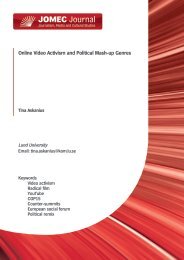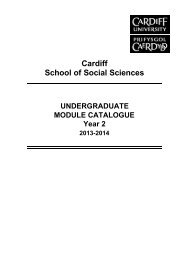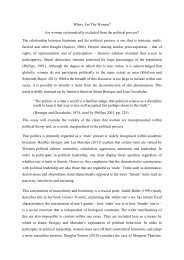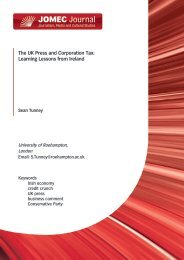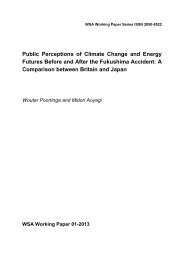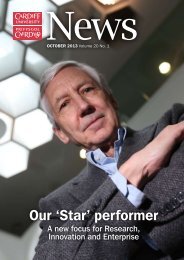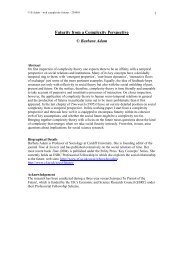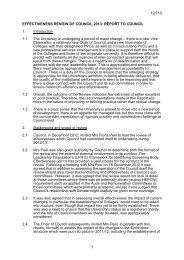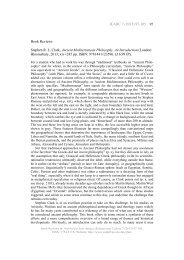APHRODITE IN PROCLUS' THEOLOGY - Cardiff University
APHRODITE IN PROCLUS' THEOLOGY - Cardiff University
APHRODITE IN PROCLUS' THEOLOGY - Cardiff University
You also want an ePaper? Increase the reach of your titles
YUMPU automatically turns print PDFs into web optimized ePapers that Google loves.
JLARC 3 (2009) 21-43 21<br />
<strong>APHRODITE</strong> <strong>IN</strong> PROCLUS’ <strong>THEOLOGY</strong><br />
Tuomo Lankila, <strong>University</strong> of Helsinki (Tuomo.Lankila@helsinki.fi)<br />
Abstract: The outlines of Proclus’ metaphysical system are fairly well known.<br />
However, the role of the particular deities in this structure is not thoroughly<br />
examined. This article deals with the place of Aphrodite within Proclus’ theology.<br />
Aphrodite has a prominent place in Proclus’ thought because devotion to her had<br />
long been under moralistic attack and Proclus carried out his defence in the context<br />
of Christian intolerance. With Neoplatonic theories of the divine series and<br />
henadology Proclus can determine different modes of the Aphrodisiac presence at<br />
all levels of reality. The tales which speak about the goddess and the meaning of<br />
the rituals dedicated to her are properly interpreted according to Proclus as symbols<br />
revealing and adoring the immaculate holiness of life.<br />
Introduction<br />
“The God is one, the gods are many”. 1 These words of Proclus (412-485) sound<br />
like an answer directed, two hundred years in advance, at Muhammad, the prophet<br />
of consistent monotheism. Proclus’ thought is a powerful synthesis of coherent<br />
philosophical monism with polytheistic theology. Anyone who ignores him would<br />
lose important evidence about how ancient religion was reflected by one of its<br />
systematically thinking insiders. Proclus’ achievement can be seen as a highly<br />
sophisticated formulation of the genuine self-understanding of a threatened, but<br />
living religion.<br />
“This is how Aphrodite is revealed; as the most uniform and purest life”, 2 is<br />
what Proclus ultimately tells us about Aphrodite. Has he turned the sweet goddess<br />
of Homer into an abstract concept of obscure metaphysics? Definitely not. If one<br />
has the patience to listen to what Proclus has to say, one will be surprised to find<br />
1 Proclus, Theologia Platonica. 3.14, 4, ed. Henri Dominique Saffrey and Leendert Gerrit<br />
Westerink, Proclus. Théologie platonicienne, vols. 1-6 (Paris, 1968-1997).<br />
2 In Platonis Cratylum commentaria 183, 53, ed. Giorgio Pasquali (Leipzig, 1908).<br />
Tuomo Lankila, ‘Aphrodite in Proclus’ Theology,’ in: Journal for Late Antique Religion and<br />
Culture 3 (2009) 21-43; ISSN: 1754-517X; Website: http://www.cardiff.ac.uk/clarc/jlarc
JLARC 3 (2009) 21-43 22<br />
many notions similar to those that modern research has discovered. Aphrodite is<br />
not primarily a goddess of tender love, she is much more. In the first place she is a<br />
goddess of reproduction and sexual desires. For ancient worshippers she was not a<br />
person to be adored, but a manifestation of a force inherent in the world. All these<br />
themes are present in the Proclean theology of Aphrodite. What is peculiar to<br />
Proclus is that he tied these issues together within a Neoplatonic interpretative<br />
context composed of the doctrines of divine series and henadology, the theory of<br />
the unfolding One.<br />
This essay aims at reconstructing the outlines of Proclus’ theology of Aphrodite.<br />
First I will address a number of passages concerning Aphrodite in Proclus’ works,<br />
their role, and how this evidence should be approached. Second, I will deal with<br />
the historical context of Proclus’ intellectual endeavour, his concept of divinity<br />
and his theory of the classes of the gods to the extent necessary for the specific<br />
topic of this study. Lastly, the material will be laid out in the order suggested by<br />
Proclus’ theory of divine hierarchy beginning from below, with Aphrodite as a<br />
terrestrial demon and proceeding to the goddess’ higher manifestations, and the<br />
interpretation of her as a hypercosmic deity.<br />
The sources of the theology of Aphrodite in Proclus<br />
We do not have any systematic treatise by Proclus on Aphrodite, although he seems<br />
to have had the intention of writing one. In the preface to his main work, Platonic<br />
Theology, he promises to give an exposition of Plato’s general theory of the gods,<br />
an enumeration of all the classes of the gods and then to discuss particular divinities<br />
celebrated in the passages of Plato’s writings. 3 The last part does not exist in extant<br />
form in the Platonic Theology. Nor is the penultimate section written according to<br />
the prescribed design, as the work ends abruptly with the discussion of the hypercosmic-encosmic<br />
order of gods. All attempts to reconstruct the Proclean theory of<br />
the cosmic and sublunar deities are therefore based on this fragmentary evidence<br />
and other works. 4<br />
The closest one comes to a Proclean work on Aphrodite is the fifteenth treatise<br />
of the Commentary on the Republic, where Proclus interprets the famous love affair<br />
between Aphrodite and Ares. In Chapter 183, of his Commentary on the Cratylus,<br />
he also deals with the etymology of the goddess’ name. In the first case the larger<br />
context is the problem of poetry as a mode for the expression of the divine truth and<br />
a parallel to the Platonic philosophy and in the latter case in the theory of language<br />
and the accuracy of names. In the case of Aphrodite, Proclus develops his views<br />
especially through the exegesis of Orphism and of Homer. In Proclus’ view these<br />
sources are complementary: Orpheus relates mainly the goddess’ higher forms,<br />
3 Theol. Plat. 1.9, 8-19.<br />
4 I will, however, exclude from consideration the Chrestomathy for its dubious authorship and<br />
also the Hypotyposis which could be regarded as a purely astronomical work.<br />
Tuomo Lankila, ‘Aphrodite in Proclus’ Theology,’ in: Journal for Late Antique Religion and<br />
Culture 3 (2009) 21-43; ISSN: 1754-517X; Website: http://www.cardiff.ac.uk/clarc/jlarc
JLARC 3 (2009) 21-43 23<br />
while Homer deals with her primarily as a cosmic deity. Proclus’ hymns offer<br />
examples of what gifts should be asked for from the individual divinities. These<br />
hymns are composed according to a stable pattern; they begin with an invocation,<br />
then enumerate attributes and powers of the god being appealed to, and at the end<br />
request something that is appropriate to this deity. 5 Two of the surviving hymns of<br />
Proclus are dedicated to Aphrodite. The first hymn celebrates the whole “foamborn”<br />
series, beginning from the goddess of the cosmic level and praising her as<br />
the mother of the different Erotes (ἐρωτοτόκος, Love-bearer). 6 The second hymn<br />
worships her as a Lycian goddess, referring to Proclus’ native country. In both of<br />
these hymns Proclus asks Aphrodite for freedom from unholy, earth-bound<br />
desires.<br />
The historical and theoretical context of Proclean theology of Aphrodite<br />
Proclus was committed to defending traditional religion, whose living space was<br />
gradually restricted, as Christianity strengthened its hold as the official ideology<br />
of the Early Byzantine state. In his time Neoplatonist philosophy had to act not<br />
only in the role of the theoretical defender of the polytheistic cults but also as a<br />
substitute for them. 7 Proclus regarded the “great confusion” in religion (his euphemism<br />
for the situation which resulted in the dominance of Christianity) as<br />
destined to fade away, although not in the foreseeable future. 8<br />
This context explains why the “correct” Platonic interpretation of myths was so<br />
important to him. Proclus thought that any interpretation of the gods that remained<br />
on the surface level, where gods were depicted as active anthropomorphic beings<br />
and their doings appeared morally questionable, would undermine the foundations<br />
of true religion and provide the Christians with weapons to attack it. 9 His radical<br />
5 M. L. West, “The Eighth Homeric Hymn and Proclus,” The Classical Quarterly 20 (1970), pp.<br />
300-304; H. D. Saffrey, “From Iamblichus to Proclus,” in Arthur Hilary Armstrong (ed.) Classical<br />
Mediterranean Spirituality (London, 1986), pp. 250-65.<br />
6 Procli hymni. 2, l 1, 13, ed. Ernst Vogt (Wiesbaden, 1957). It would be tempting to think that<br />
with this epithet Proclus is intentionally echoing and developing a parallel to the evolving Christian<br />
doctrine of Mary.<br />
7 Proclus explicitly says so in praising his teacher Syrianus, in Proclus, In Platonis Parmenidem<br />
618, 9-13, ed. Victor Cousin, vol. 3, (Paris, 1864, repr. Hildesheim, 1961).<br />
8 In Remp 1, 74,8-9: ... τὴν παροῦσαν ... δεινὴν καὶ ἄτακτον σύγχυσιν τῶν ἱερῶν θεσμῶν<br />
(horrible disorder in religion under present conditions). The same word with the same intention is<br />
used also In Parm. 954,1-2 and Proclus, Procli Diadochi in Platonis Timaeum commentaria, ed.<br />
Ernst Diehl (Leipzig, 1903-1906) 3.44, 6. See the list of the expressions referring to Christianity in<br />
the works of Proclus and Marinus in Saffrey, “Allusions anti-chrétiennes chez Proclus, le diadoque<br />
platonicien,” Revue des Sciences philosophiques et théologiques 59 (1975), pp. 553-63.<br />
9 Possibly the reference to οἱ καθ’ ἡμᾶς ἄνθρωποι (men of our time) In Remp. 1.74, 4, as people<br />
who attribute this responsibility to the ancient myths, does not mean Christians as André-Jean<br />
Festugière thought, (in Proclus, Commentaire sur la République I (Paris, 1970), p. 92, n. 1). It may<br />
rather refer to pagan intellectuals, who were seeking causes for the ascendancy of the new religion,<br />
Tuomo Lankila, ‘Aphrodite in Proclus’ Theology,’ in: Journal for Late Antique Religion and<br />
Culture 3 (2009) 21-43; ISSN: 1754-517X; Website: http://www.cardiff.ac.uk/clarc/jlarc
JLARC 3 (2009) 21-43 24<br />
thesis was that myth, which is most incompatible with conventional notions of<br />
justice and decency could refer through symbols to the highest divine principles.<br />
With the help of proper exegesis one can ascend from the scandalous layer of<br />
mythology, find hidden truths and forge a genuinely pure cult of the gods. 10<br />
Proclus, for whom the ideal philosopher should be “a hierophant of the whole<br />
world”, 11 tries to find a place for different modes of seeing divinity within a<br />
framework built on a Neoplatonic view on reality articulated in levels, grades, and<br />
degrees.<br />
Science of divine unities as a basis of piety<br />
Neoplatonism identifies theology with henology, the doctrine of the One. The One<br />
is good and the Good is the God. Divinity is the same thing as unity, unification<br />
means deification, and divinity is the guarantor, origin and source of essence for<br />
all being. 12 In the strict sense the gods are for Proclus only the One and its participated<br />
classes in the primal being; these are the so-called “self-perfect henads<br />
(unities)”. 13 Unity is present on all levels of reality, however, down to the edge of<br />
and against whose opinion Proclus wanted to rehabilitate mythology with allegorical and symbolic<br />
exegesis.<br />
10 Regarding the theological myths in Homer, Hesiod and Orpheus see the sixth treatises in In<br />
remp., especially 82,21-83,7 and Theol. Plat. 5.17,10-18,28, especially 5.17,25-18.1: Πάντα γὰρ<br />
τὰ τοιαῦτα τοὺς μὲν πολλοὺς καὶ ἀνοήτους οἴεται δι’ ἄγνοιαν τῶν ἐν αὐτοῖς ἀπορρήτων διαβάλλεσθαι,<br />
τοῖς δὲ σοφοῖς ἐνδείκνυσθαί τινας ὑπονοίας θαυμαστάς. (“He (Plato) believes that all<br />
(myths) of this kind deceive the ignorant multitude incapable to grasp secrets in them, while they<br />
suggest to wise people admirable hidden meanings.”) In the scholarly literature these issues are<br />
well discussed by e.g. Jean Trouillard, La Mystagogie de Proclos (Paris, 1982). On the Proclean<br />
interpretation of mythology see, for example, James A. Coulter, The Literary Microcosm (Leiden,<br />
1976); Anne D.R. Sheppard, Studies on the 5th and 6th Essays of Proclus’ Commentary on the<br />
Republic (Göttingen, 1980); Robert Lamberton, Homer the Theologian (Berkeley, 1986); Oiva<br />
Kuisma, Proclus’ Defence of Homer (Helsinki, 1996). Important contributions which also deal<br />
with, among other themes, the problem of Aphrodite in Proclus are Michael Erler, “Interpretieren<br />
als Gottesdienst,” in Gilbert Boss and Gerhard Seel, Proclus et son influence (Zürich, 1987), pp.<br />
180-217; Robbert M. van den Berg Proclus’ Hymns (Leiden, 2001); and Robbert M. van den Berg<br />
Proclus’ Commentary on the Cratylus in Context (Leiden, 2008).<br />
11 Marinus, Vita Procli sive de felicitate 19, ed. R. Masullo (Naples, 1985).<br />
12 Theol. Plat. 1.114, 5-116,3 Theol. Plat. 1.119,9-14, In Parm. 641,11: τὸ ἡνῶσθαι τῷ τεθεῶσθαι<br />
ταὐτόν (unifying is the same as deifying), In Parm. 1068,6-8: καὶ οὐδὲν ἄλλο ἐστὶν ἕκαστος τῶν<br />
θεῶν ἢ τὸ μετεχόμενον ἕν (each of the gods is nothing more than participated one), In Parm.<br />
1096,28-29: ταὐτὸν τὸ αὐτοὲν καὶ θεὸς, καὶ οὔ τις ἐκεῖνο θεὸς, ἀλλ’ αὐτοθεός (one itself is the<br />
same as god, and it is not any of the gods, but the God itself).<br />
13 Pursuing absolute purity of transcendence in the first principle, Proclus posits the absolutely<br />
imparticipable One and a derived class of the primordial unities (henads) which open themselves<br />
for participation by beings. Independent henads are supraessential unities participated in by the<br />
root members (imparticipable monads) of the ontological series (such as chains of beings, lives,<br />
intellects, and souls). The derived henads presents unity in the secondary members of these classes<br />
of being (from a participated monad to the last member of the respective class) and also in the<br />
Tuomo Lankila, ‘Aphrodite in Proclus’ Theology,’ in: Journal for Late Antique Religion and<br />
Culture 3 (2009) 21-43; ISSN: 1754-517X; Website: http://www.cardiff.ac.uk/clarc/jlarc
JLARC 3 (2009) 21-43 25<br />
pure matter, and in this sense the Neoplatonists accept the Presocratic dictum that<br />
everything is full of gods. 14 The gods of Olympus find their place in the Proclean<br />
hierarchy far below the self-perfected henads, but even they, Aphrodite among<br />
them, are certain manifestations of unity.<br />
Thus the same divinity known by a certain mythological name could be present<br />
and is necessarily present on different levels of reality. 15 Modern research on the<br />
Neoplatonist hierarchy of the gods has located Plato’s lower Aphrodite on the level<br />
of hypercosmic-encosmic gods. Luc Brisson, for example, finds her exactly in the<br />
second term of the fourth triad of the dodecad formed by the hypercosmic-encosmic<br />
deities. 16 It is more difficult to situate the first Aphrodite however. 17<br />
At every level the task of the gods qua gods is to generate, to produce and to<br />
exercise providence towards the universe. 18 Human beings interact with this providential<br />
activity through religious cult and prayer. For Proclus ideal prayer presupposes<br />
precise knowledge of all the classes of gods. 19 We can see a model of<br />
this kind of prayer in the prefaces of Proclus’ main works, which Proclus habitually<br />
opens with a prayer. At the beginning of the Commentary on Parmenides he asks<br />
for appropriate help from each divine class for the reception of the mystical vision<br />
of Plato. 20 However, to understand this correctly: The One and the highest henads<br />
are not receivers of prayers linked with human language. These highest divinities<br />
should be worshiped only transcending intellect in silence and by the unification<br />
prior to silence. 21<br />
things of the world of becoming, mediating for them the illumination of oneness. The supraessential<br />
henads are the gods, whereas the illumination of oneness is a god in each thing and the highest<br />
summit of its existence. This theory is exposed in Proclus, Elements of Theology, ed. Eric R.<br />
Dodds (Oxford, 1963), propositions 2, 6, 64, and 113-162 and the third book of Platonic Theology.<br />
For modern research on the topic see especially the first chapter in the introduction to the latter<br />
work, Saffrey and Westerink, Théologie platonicienne 3 (Paris, 1978), pp. ix-lxxxvii; Christian<br />
Guérard, “La théorie des hénades et la mystique de Proclos,” Dionysius 6 (1982) 73-82, and P.A.<br />
Meijer, “Participation in henads and monads in Proclus’ Theologia Platonica III, chs, 1-6,” in E.P.<br />
Bos and P. A. Meijer, On Proclus and His Influence in Medieval Philosophy (Leiden, 1992), pp.<br />
65-88.<br />
14 Proclus refers explicitly to this dictum in De sacrificio et magia 149, 26 ed. Joseph. Bidez,<br />
Catalogue des manuscrits alchimiques grecs 6 (Brussels, 1928).<br />
15 For clear example of how to understand different stages of the series (here the series of Apollo)<br />
see In Remp. 1.147,6-15.<br />
16 Luc Brisson, “Proclus et l’Orphisme,” in his Orphée et l’Orphisme dans l’Antiquité grécoromaine<br />
(Aldershot, 1995), p. V.86 and How Philosophers Saved Myths (Chicago, 2004), p. 98.<br />
17 I will not try to expound here the whole structure of Proclus’ divine world. Relevant levels<br />
for the location of Aphrodite can be seen in the appended table. For a more synoptic view see the<br />
appendices in Brian Duvick, Proclus, On Plato Cratylus (London, 2007), pp. 173-75, and Hans<br />
Lewy, Chaldaean Oracles and Theurgy (Paris, 1978), pp. 483-85.<br />
18 Theol. Plat. 5.108, 3, ET prop. 120.<br />
19 In Tim. 1.209,9-11.<br />
20 Proclus, In Parm. 617. Both the In Parm. and Theol. Plat. begins with a prayer to the gods and<br />
praising Proclus’ teacher Syrianus.<br />
21 Theol. Plat. 3.30,4-8.<br />
Tuomo Lankila, ‘Aphrodite in Proclus’ Theology,’ in: Journal for Late Antique Religion and<br />
Culture 3 (2009) 21-43; ISSN: 1754-517X; Website: http://www.cardiff.ac.uk/clarc/jlarc
JLARC 3 (2009) 21-43 26<br />
Demonic Aphrodite<br />
In his Commentary on the Republic Proclus gives an exegesis of the Judgment of<br />
Paris. 22 He uses the alternative mythological name for Paris, Alexander, and sometimes<br />
speaks only of the “barbarian”. His interpretation has both a demonological<br />
and psychological interest. In his view the sheer idea of a real quarrel between the<br />
goddesses is monstrous and should be rejected. There has never been a verdict of<br />
a mortal barbarian on the goddesses. His explanation for the human perceptions of<br />
divine visions is that they concern lower links in the divine chains and that the gods<br />
reveal themselves to the soul’s internal faculty of fantasy, which has its material<br />
part in the so-called pneumatic vehicle of the soul. 23 Denying the historicity of<br />
Paris’ judgment Proclus in this particular case avoids taking a stance concerning<br />
the reality of divine epiphanies. As far as he is concerned the mythologists have<br />
here represented relationships outside space and time as an event in mythological<br />
history.<br />
The core of Paris’ story in Proclus is psychological. Proclus’ exegesis is based<br />
on the doctrine of the modes of the soul’s life as found in Plato’s Phaedrus. When<br />
coming into the world souls choose, under divine supervision, a form of life that<br />
corresponds to their dispositions. A kingly life is dependent on Hera, a philosophical<br />
one on Zeus (represented by Athena in the tale of Paris), a loving one on Aphrodite.<br />
Proclus’ description of Paris’ choice is typically Platonist: A blind soul cannot<br />
recognize its own good. Paris’ choice therefore is “careless, a throwing of oneself<br />
on sensible beauty and pursuing the idol of intelligible beauty.” 24 If he had been in<br />
Paris’ position, Proclus would of course have given the prize to Athena. This would<br />
have been the philosopher’s solution and especially appropriate to Proclus who<br />
has a special relation to this goddess. 25<br />
In Remp. 1. 108, 23-109, 1: ὁ μὲν γὰρ ὄντως ἐρωτικὸς νοῦν καὶ φρόνησιν προστησάμενος<br />
καὶ μετὰ τούτων τό τε ἀληθινὸν κάλλος καὶ τὸ φαινόμενον θεωρῶν οὐχ<br />
ἧσσόν ἐστιν Ἀθηναϊκὸς ἢ Ἀφροδισιακός·ὁ δὲ αὐτὸ καθ’ αὑτὸ μόνον τὸ ἐρωτικὸν<br />
εἶδος ἐπιδιώκων μετὰ πάθους ἀφίσταται μὲν τῶν ἀληθινῶν καλῶν καὶ ἀγαθῶν,<br />
ὑπὸ δὲ ἀνοίας καὶ λαιμαργίας ἐπιπηδᾷ τῷ εἰδώλῳ τοῦ καλοῦ καὶ περὶ τοῦτο κεῖται<br />
πεσών, οὐδὲ τῆς τῷ ἐρωτικῷ συμμέτρου τελειότητος τυχών.<br />
An authentic eroticism, with has taken understanding and wisdom to be its guides,<br />
and can distinguish with aid of these between real and apparent beauty, does not<br />
belong less to Athena than Aphrodite ... But he who pursues exclusively and<br />
passionately only the life of love draws himself away from the really beautiful and<br />
22 In Remp. 1.108, 1-109, 7.<br />
23 For the theory of epiphany see In Remp. 1. 39, 1-40, 3.<br />
24 In Remp. 1. 108, 20-22.<br />
25 Marinus tells us that Athena moved to live with Proclus after her statue was removed from<br />
the Parthenon, Marinus, Vita Procli 30, see also 6 ,9 ,15, and 29.<br />
Tuomo Lankila, ‘Aphrodite in Proclus’ Theology,’ in: Journal for Late Antique Religion and<br />
Culture 3 (2009) 21-43; ISSN: 1754-517X; Website: http://www.cardiff.ac.uk/clarc/jlarc
JLARC 3 (2009) 21-43 27<br />
good, and with the desire and trust of the glutton grasps at the idol of beauty and<br />
remains joined to the fall without accessing the perfection appropriate to the real<br />
eroticism (translation mine).<br />
Proclus does not condemn the pursuit of earthly love as such. Neither should<br />
his thoughts regarding the contrast between the goddesses be interpreted in a<br />
manner that would equate Aphrodite with an amorous life driven by passion. But<br />
the goddess is not only these aspects, especially contemplated as a leading deity in<br />
her own divine series. The real erotic summit belongs to Aphrodite:<br />
In Remp. 1. 109, 1-3: ὁ γὰρ δὴ τελέως ἐρωτικὸς καὶ Ἀφροδίτῃ μέλων ἐπ’ αὐτὸ τὸ<br />
θεῖον κάλλος ἀνάγεται τῶν ἐν αἰσθήσει καλῶν ὑπερορῶν.<br />
...because a perfectly erotic being, who is taken care of by Aphrodite, ascends towards<br />
divine beauty itself, despising the beautiful things on the level of the sensible<br />
(translation mine).<br />
Proclus thus links Aphrodite with the authentic erotic madness which functions<br />
as a springboard for the soul's purification. 26 However, Aphrodite’s series also<br />
provides for those beauties that are perceptible on the corporeal and material<br />
levels.<br />
In Remp. 1.109,3-7.: ἐπεὶ δὲ καὶ τοῦ ἐμφανοῦς κάλλους καὶ τοῦ ἐν ὕλῃ τὴν ὑπόστασιν<br />
ἔχοντος εἰσί τινες Ἀφροδισιακοὶ προστάται δαίμονες, διὰ δὴ τοῦτο καὶ ὁ τὸ<br />
εἴδωλον περιέπων συνεργοῦ λέγεται τῆς Ἀφροδίτης τυγχάνειν<br />
At the same time there exists certain aphrodisiac demons who supervise apparent<br />
beauty and that which is seen in matter and, because of that, it is said that such a<br />
person who respects an idol has gained the help of Aphrodite (translation mine).<br />
In the Commentary on the Republic Proclus discusses divine possession in connection<br />
with Aphrodite. 27 He cites with evident approval the argument of his predecessor,<br />
the Neoplatonist Theodore of Asine, that divine possession could also<br />
happen to women. Theodore’s example is Helen of Sparta. Aphrodite filled Helen<br />
with graces regarding her soul and body to such an extent that Helen was born to<br />
be like a new Aphrodite, who coming from the sky, cheated the barbarian (i.e.,<br />
Paris) into thinking that he possessed something that he did not in reality. Helen<br />
with whom Paris lived was not real but some kind of idol. The Egyptians among<br />
whom Helen lived taking part in the holy rituals have kept in their memory an<br />
authentic image of Helen, but among the Greeks “men of the theater” slandered<br />
26 On this salvific role of love see also, for example, De sacrificio et magia 148, 1-3; Theol.<br />
Plat. 1. 113,.4-10.<br />
27 In Remp. 1 254,29-255,28.<br />
Tuomo Lankila, ‘Aphrodite in Proclus’ Theology,’ in: Journal for Late Antique Religion and<br />
Culture 3 (2009) 21-43; ISSN: 1754-517X; Website: http://www.cardiff.ac.uk/clarc/jlarc
JLARC 3 (2009) 21-43 28<br />
her with stories that have no true basis. Proclus does not openly express himself in<br />
favour of Helen’s holiness. The context in which he discusses the question is the<br />
traditional Platonist defence of the identity of the virtues of men and women. The<br />
story narrated by the philosopher of Asine offers one argument more to Proclus in<br />
this task. However it is clear that Proclus’ resorting to this argument shows that<br />
he believed in the possibility of real divine possession.<br />
In the Commentary on the Cratylus 28 Proclus expresses precise opinions on the<br />
theory of divine series, how demons acting in the material world should be seen as<br />
the extremities of these divine series. In his view terrestrial spirits and particular<br />
demons participate in the divine demiurgy as co-producers of beings of the sensible<br />
world The myth-makers use the same names to refer both to the leaders of the<br />
series and to the lower spirits. Proclus thinks that the very last members of the<br />
divine series can in fact have intercourse with humans and thus generate heroes.<br />
This is not surprising as the lowest demons are sympathetic not only to humans,<br />
but also to other species of living beings, and this is why we have cases of nymphs<br />
joining to trees, wells, deer and snakes.<br />
Proclus connects the question about the relation between Aphrodite and Eros to<br />
the relations of the (celestial) gods and demons. He reminds us that Plato calls Eros<br />
a demon in the Symposium, saying that he is a companion of Aphrodite, and originates<br />
from Poros, who is a real god, whereas in the Phaedrus Plato calls Eros<br />
himself a god, because he is an uplifting life force. 29 Thus the case of Eros also<br />
shows that the demons are companions and followers of the gods. But this is not<br />
the whole truth of the relationship between Eros and Aphrodite, as we will see in<br />
the treatment of the gods on the higher levels of the hierarchy.<br />
Cosmic Aphrodite<br />
Proclus’ consideration of Aphrodite as a cosmic deity includes purely astronomical<br />
issues, but also such which are relevant for theology. Aphrodite and Hermes are<br />
sunny stars, because they help the Sun in its creative action and collaborate with it<br />
in order for all things to fulfil their destiny. As a cosmic monad the Sun is “miraculous,<br />
unsurpassable, a disproportionate power in itself and with all others.” 30<br />
We see here the Sun’s relation to the visible world matching the relation of the<br />
demiurge to the cosmos, and this again mirrors the relation of the One to reality.<br />
Aphrodite and Hermes present themselves as inseparable companions of Helios in<br />
the cosmic demiurgy. They set their own movement in harmony with the creative<br />
act of this star. They bring proportion and symmetry and a happy mixing to all<br />
things. 31 Aphrodite and Hermes depart and approach the Sun as his bodyguards. 32<br />
28 In Crat. 118,1-26.<br />
29 In Tim. 3.154,27-30.<br />
30 In Tim. 3. 65,30-66,2.<br />
31 In Tim. 3.66,2-5.<br />
Tuomo Lankila, ‘Aphrodite in Proclus’ Theology,’ in: Journal for Late Antique Religion and<br />
Culture 3 (2009) 21-43; ISSN: 1754-517X; Website: http://www.cardiff.ac.uk/clarc/jlarc
JLARC 3 (2009) 21-43 29<br />
Both Hermes and Aphrodite are unifying principles in the world according to<br />
Proclus, Hermes “takes part in the making of the daily and nightly phenomena and<br />
masculinizes and feminizes itself,” while Aphrodite participates in the creative acts<br />
of the solar monad “for she has the ability to bind and adjust that which has been<br />
separated.” 33<br />
Proclus says that Aphrodite unifies and leads Hermes’ and Helios’ actions to a<br />
communion, and gives harmony to that which is in the one careless (ἀνειμένην)<br />
and in the other stretched (ἐπιτεταμένην), whatever these qualities may mean for<br />
Hermes’ and Helios’ demiurgy. 34 Proclus describes Sun’s celestial companions as<br />
a cosmic image of the noetic triad:<br />
In Tim. 3.66,13-24: καὶ μήποτε ... ταῖς πρώταις τρισὶ μονάσι ταῖς ἐν προθύροις<br />
τἀγαθοῦ προῆλθον ἀνὰ λόγον ὁ μὲν γὰρ ἥλιος, ὡς ἐμάθομεν ἐν Πολιτείᾳ , τῆς<br />
ἀληθείας εἰκόνα τὸ φῶς ὑπέστησεν, ἡ δὲ Ἀφροδίτη κάλλους ἐστὶν αἰτία τοῖς<br />
γενητοῖς, ὅ ἐστιν ἐκείνου μίμημα τοῦ κάλλους, ὁ δὲ Ἑρμῆς συμμετρίας πᾶσιν<br />
αἴτιος λόγος ὢν τοῖς περὶ τὴν γένεσιν· πᾶσα γὰρ συμμετρία καθ’ ἕνα πρόεισι λόγον<br />
καὶ κατ’ ἀριθμόν, ὧν ἐστιν ὁ θεὸς οὗτος δοτήρ. ἐκείνων οὖν τῶν μονάδων ὄντες<br />
ἀνὰ λόγον μετ’ ἀλλήλων οὐσῶν εἰκότως καὶ αὐτοὶ συνεῖναι ἀλλήλοις ἐφίενται<br />
καὶ συμπεριπολεῖν.<br />
Perhaps these stars have appeared into the cosmos in analogy with the first three<br />
monads ... these monads we find at the vestibule of the good (a reference is to<br />
Plato's Philebus 64c). 35 And indeed, as we have learned from the Republic (VI<br />
508b12) the sun produces the light as a likeness of truth, and Aphrodite is the cause<br />
of beauty for the beings in cosmos and the copy of the beautiful beings in the<br />
noetic triad. Calculating Hermes is the cause of proportion for all beings in the<br />
world of becoming ... Like the sun, Aphrodite and Hermes are also analogous to<br />
these mutually unified monads and because of this they also want with justice to<br />
come together and create their cycle in concert (translation mine).<br />
Since Proclus returns to the analogy of the cosmic world and intelligible triads<br />
in other passages, 36 it is clear that the correspondence is not for him a casual result<br />
of exegetic zeal.<br />
In this same place in the Commentary on the Timaeus, 37 where the main issue<br />
to be dealt with is the world’s body, Proclus explains that the planetary deities are<br />
32 In Remp. 2.59,1.<br />
33 In Tim. 3.65,5-8. Aphrodite was represented in some statues also with beard; cf. William<br />
Sale, “Aphrodite in the Theogony,” Transcations and Proceedings of the American Philological<br />
Association 92 (1961), pp. 508-521. Proclus associates hermaphroditic traits only to Hermes.<br />
34 In Tim. 3. 67.<br />
35 It is not quite obvious where Proclus situates the vestibule of the Good. On the grounds of<br />
similarities in this passages and Theol.Plat. 3.64,8-12 I am inclined to think that he means the last<br />
term of the noetic triad which is characterized by the monads of symmetry, truth and beauty.<br />
36 In Tim. 3.69, 5-69, 14.<br />
37 In Tim. 3.69,15-27.<br />
Tuomo Lankila, ‘Aphrodite in Proclus’ Theology,’ in: Journal for Late Antique Religion and<br />
Culture 3 (2009) 21-43; ISSN: 1754-517X; Website: http://www.cardiff.ac.uk/clarc/jlarc
JLARC 3 (2009) 21-43 30<br />
the causes of the passionate and cognitive powers of humans as far as the subject<br />
of consideration is the composite of body and soul and the soul’s two lower, i. e.<br />
irrational, parts (the powers of the rational soul naturally depend on a higher place<br />
in the divine hierarchy). The moon, “the visible image of the source of nature,” is<br />
the cause of physical growth, the sun produces the totality of the sensations, and<br />
Hermes is the cause of the movements of the imagination (of the movements only,<br />
Proclus specifies, since “the cause of the fantastic faculty as such is Helios, since<br />
sensation and imagination form the same faculty”). Aphrodite produces the lustful<br />
desires of the lower irrational soul, Ares the movements of anger, depending on<br />
nature. Zeus produces vital powers universally, and Cronus, in the same manner,<br />
cognitive powers.<br />
The task of the planetary gods is to join the age period of the human being to the<br />
seven divine series. Proclus gives his most detailed description of this issue in his<br />
Commentary on Plato’s Alcibiades, 38 in a manner which corresponds, albeit with<br />
some strain, to the theory just outlined. “The third (period) is that which belongs<br />
to the series of Aphrodite as boys begin to produce sperm and set in motion the<br />
natural powers of child-making”. The role of Helios in this picture forces Proclus<br />
actually to identify the noon of life with the life epoch of a young man, and the<br />
agreement with the previously-mentioned theory in the Commentary on the Timaeus<br />
is not altogether successful, but unsurprising as far as the exegesis regards<br />
Aphrodite.<br />
Once more in the Commentary on the Timaeus Proclus returns to the question<br />
of Aphrodite and the desiring soul when he starts to deal with the structure of the<br />
human body. 39 This anatomical exegesis does not advance very far, because the<br />
manuscripts break off here. Proclus sets the planetary gods in connection with the<br />
human faculties referring to what “someone has said”. This expression implies perhaps<br />
a slightly reserved attitude to the theory that is expounded. The most interesting<br />
trait in this passage is that Proclus places Hermes as a discursive faculty between<br />
the thymos of Ares and the epithymetikon of Aphrodite. And how indeed could he<br />
do otherwise, seeing that he has to treat the divinities in their natural, planetary,<br />
order, going this time from top to bottom, from the sphere of the fixed stars to the<br />
level of the moon? He then continues establishing a correspondence between our<br />
pneumatic body with the sky and our mortal body with the sublunar world. But<br />
neither does this passage have anything surprising to say about Aphrodite.<br />
With respect to the theory of the body of the world, Proclus rejects the doctrine<br />
of correspondences between divinities and elements. 40 In this doctrine, which is<br />
Pythagorean according to Proclus, the element of Aphrodite is air. Proclus says<br />
that the Pythagoreans have the correct opinions insofar as they regard Aphrodite<br />
and Hermes as gathering and unifying divinities. Their doctrine of the elements<br />
38 Proclus, In Platonis Alcibiadem 1.196.2-19 ed. Alain Philippe Segonds, Proclus. Sur le premier<br />
Alcibade de Platon (Paris, 1985-1986).<br />
39 In Tim. 3.354,29-355,20.<br />
40 In Tim. 2.48,15-49, 12.<br />
Tuomo Lankila, ‘Aphrodite in Proclus’ Theology,’ in: Journal for Late Antique Religion and<br />
Culture 3 (2009) 21-43; ISSN: 1754-517X; Website: http://www.cardiff.ac.uk/clarc/jlarc
JLARC 3 (2009) 21-43 31<br />
differs from the Platonic, which sees all elements as present in each planetary sphere<br />
in the same way as the sublunar elements participate in each other.<br />
When it comes to dedicating seasons to divinities, Proclus accepts this theory. 41<br />
Cronus and Ares, winter and summer, form an opposite pair, while Zeus and<br />
Aphrodite, spring and autumn, form another. The connection between Aphrodite<br />
and autumn is easy to understand: “... autumn belongs to Aphrodite,” Proclus says,<br />
“because during this season seed is thrown to earth and the task of Aphrodite is to<br />
mix fertile germs and lead them to communion with the cause of becoming.”<br />
Proclus sees Aphrodite as a demiurgic power that brings into harmony and<br />
unification the masculine and feminine, ideal forms and matter in cosmos. 42 This<br />
is why he also interprets the office for the supervising public marriages in Plato’s<br />
treatment of the ideal state as being analogous to Aphrodite.<br />
A final Aphrodisiac item of the cosmos belongs to the area of astrology. Each<br />
star has special mutual positions which are dangerous to the development of the<br />
embryo. If Aphrodite has been in this adverse position during the conception, this<br />
destroys the seed at the 120th day of pregnancy. Proclus does not say if he held<br />
this opinion, he states it as a rule of the Egyptians. 43<br />
Aphrodite as a hypercosmic-encosmic deity<br />
On the next level up, the hypercosmic-encosmic order, Proclus posits a divine dodecad<br />
which corresponds to the twelve gods of the Phaedrus.<br />
Theol. Plat. 6.85,6-12: Τοὺς τοίνυν ἀπολύτους πάντας θεοὺς ἀπερίληπτον ἔχοντας<br />
πλῆθος καὶ ταῖς ἀνθρωπίναις ἐπιβολαῖς ἀναρίθμητον, ἐνταῦθα κατὰ τὸ τῆς δωδεκάδος<br />
μέτρον ἀφορίζει. Καίτοι γε οὔτε τῶν θεολόγων ὅσοι τι περὶ αὐτῶν γεγράφασιν<br />
ὁρίσαι δεδύνηνται τὸν ὅλον αὐτῶν ἀριθμόν, ὥσπερ τὸ ἀρχικὸν πλῆθος<br />
ἢ τὸ τῶν νοερῶν θεῶν ἢ τὸ τῶν νοητῶν·<br />
The plurality of these deities is incomprehensible and impossible to enumerate for<br />
human intuition but inspired Plato defines them in Phaedrus’ vision with the model<br />
of a dodecad. None of the theologians, who have written something about them,<br />
has been able to define the perfect number of these divinities, as opposed to that<br />
plurality which relate to the primordial principles, noeric gods, and noetic gods<br />
(translation mine).<br />
With these previous gods Proclus probably means the first henads derived from<br />
the One — the limit and the infinite — and the noetic and noetic-noeric triads<br />
41 In Remp. 2.62,6-18.<br />
42 In Tim. 1.34,15-17.<br />
43 In Remp. 2.58, 20. See Festugière’s note in Proclus. Commentaire sur la République 2 (Paris,<br />
1970), p. 167 n. 1.<br />
Tuomo Lankila, ‘Aphrodite in Proclus’ Theology,’ in: Journal for Late Antique Religion and<br />
Culture 3 (2009) 21-43; ISSN: 1754-517X; Website: http://www.cardiff.ac.uk/clarc/jlarc
JLARC 3 (2009) 21-43 32<br />
mentioned above. Proclus believes that for Plato the number twelve is appropriate<br />
to these divinities, which are called “unchained”, because the dodecad is wholly<br />
perfect, being composed of primordial principles and the most perfect ingredients<br />
and covering the entire procession of being with its measure. 44 This obscure manner<br />
of expression refers to the fact that twelve is the result of the multiplication of three<br />
by four, the triad being the structure of conversion and perfection and the tetrad<br />
the structure of stability and harmony.<br />
Thus twelve divinities are divided into four triads, of which we are interested<br />
here only in the properties of the last “uplifting” triad (Hermes, Aphrodite, and<br />
Apollo) and the last members of the immediately preceding triads, in other words<br />
the gods Hephaestos and Ares, because of the obvious mythological importance of<br />
these gods for Aphrodite. Hephaestos’ function is to install “nature in bodies and<br />
construct the abodes of the cosmic gods.” 45<br />
The most universal and first species of life originate in the second and third<br />
terms of the uplifting triad (Aphrodite and Apollo) together with the last term of<br />
the previous triad (Ares). Souls are installed into their modes of life according to<br />
these divinities when they descend to the cosmos.<br />
Souls ascend through the same triad. Philosophy (Hermes), love (Aphrodite),<br />
and the cult of the gods (Apollon) recuperate all that was lost in the process of<br />
becoming. Aphrodite acts as a primordial cause of loving inspiration, which permeates<br />
universally all things and orientates uplifted lives towards primal Beauty<br />
(third triad of the first intelligible triad). 46<br />
This view of the souls’ road to salvation is at first glance in accordance with the<br />
famous passage of the Platonic Theology often cited as a Proclean “definition” of<br />
theurgy. 47 The highest path of ascent there links the theurgic power, faith and the<br />
good, the second salvific channel goes from philosophy through truth to wisdom,<br />
and the third from the erotic madness through love to beauty. Hermes and Apollo<br />
do not always seem to occupy the same position in the works of Proclus but<br />
Aphrodite is similar in both the first and the sixth part of the Platonic Theology.<br />
The fifteenth treatise of Proclus’ Commentary on the Republic 48 is dedicated to<br />
the relation of Aphrodite, Ares, and Hephaestos, inquiring into the role of these<br />
divinities in cosmogony from the hypercosmic to the sensible order.<br />
Proclus says that Hephaestos and Ares are both acting “towards” the whole of<br />
reality. Ares separates the opposing principles of wholeness and saves them as<br />
immutable and intact in order that the world should always be fulfilled by all forms.<br />
In accordance with his art Hephaestos creates the perceptible world order and fills<br />
nature with generative principles and forces. The symbols of these are the celestial<br />
tripods mentioned in the Iliad (18, 373). The brooches, spiral armlets, cups, and<br />
44 Treatise on the twelve gods, Theol. Plat. 6.97,1-99, 21.<br />
45 Theol. Plat. 6.97,16-17.<br />
46 Theol. Plat. 6.98, 18-21.<br />
47 Theol. Plat. 1.113,4-10.<br />
48 In Remp. 1.141,1-143,16.<br />
Tuomo Lankila, ‘Aphrodite in Proclus’ Theology,’ in: Journal for Late Antique Religion and<br />
Culture 3 (2009) 21-43; ISSN: 1754-517X; Website: http://www.cardiff.ac.uk/clarc/jlarc
JLARC 3 (2009) 21-43 33<br />
chains mentioned a little bit later in the same song are, for Proclus, symbols of the<br />
forms of the sublunar world, which Hephaestos casts.<br />
Both gods need Aphrodite for their deeds, one to bring harmony and order to<br />
opposites, the other to bring perceptible beauty and shining clarity to his creation<br />
so that this world could be made into the most beautiful of sensible things.<br />
Aphrodite is present everywhere but Hephaestos “participates” to her in the mode<br />
of the higher realities. We find in this exegesis four different levels of demiurgy.<br />
There are two pairs: where Hephaestos manifests the higher and Ares the lower<br />
demiurgy. Hephaestos mode of participation in Aphrodite is hypercosmic and<br />
celestial, that of Ares encosmic and sublunar.<br />
Mythology conceals and reveals Hephaestos’ mode of action, saying that he takes<br />
Aphrodite as his spouse to observe the will of Zeus. Ares’ relation to the goddess is<br />
called adultery by the myths.<br />
In Remp. 1.141,26-142,5: τῷ μὲν γὰρ δημιουργῷ τῶν αἰσθητῶν κατὰ φύσιν ἐστὶν<br />
ἡ πρὸς τὴν καλλοποιὸν αἰτίαν καὶ συνδετικὴν κοινωνία, τῷ δὲ τῆς διαιρέσεως<br />
προστάτῃ καὶ τῆς ἐναντιώσεως τῶν ἐγκοσμίων ἀλλοτρία πώς ἐστιν ἡ τῆς<br />
ἑνώσεως χορηγὸς δύναμις· τοῖς γὰρ συναγωγοῖς τὰ διακριτικὰ γένη τῶν θεῶν<br />
ἀντιδιῄρηται. ταύτην τοίνυν τὴν τῶν ἀνομοίων αἰτίων σύμπνοιαν οἱ μῦθοι<br />
μοιχείαν προσειρήκασιν.<br />
For the maker of sensible things a coupling with the cause which creates beauty<br />
and binds things together is natural, whereas for the god, who oversees division<br />
and opposition in worldly things, for him the unifying force is somehow alien. The<br />
separating classes of the gods are directly opposed to the classes which are<br />
unifying. Because of this, the myths call a union of the different causes adulterous<br />
(translation mine).<br />
But this kind of union is also necessary for the cosmogony, “in order to bring<br />
opposites into harmony and so that the internal war of the world will end into<br />
peace.” 49<br />
At every level oppositon is the gift of Ares. On the celestial level it refers to the<br />
mutual strife between forms when they try to oust each other, while on the terrestrial<br />
level it refers to the struggle of the elements and forces. As Helios is the companion<br />
of Hephaestos in the production of universal forms, he denounces the intercourse<br />
of Ares and Aphrodite to Hephaestos. The chains of Hephaestos, by means of which<br />
he captures Ares and Aphrodite, are forces invisible to others and in using them<br />
Hephaestos “builds from the opposites of Ares and Aphrodite’s joining virtues a<br />
unified order, since becoming needs both of them.” 50<br />
Hephaestos’ chains are different in the celestial and the sublunar world. The<br />
former are indissoluble, while it is possible to loose the latter. Proclus also finds<br />
the word “chain” to be a uniting physical force in Plato’s Timaeus and this is<br />
49 In Remp. 1.141, 7-142, 7.<br />
50 In Remp. 1.142,17-19.<br />
Tuomo Lankila, ‘Aphrodite in Proclus’ Theology,’ in: Journal for Late Antique Religion and<br />
Culture 3 (2009) 21-43; ISSN: 1754-517X; Website: http://www.cardiff.ac.uk/clarc/jlarc
JLARC 3 (2009) 21-43 34<br />
enough for him to equate the demiurgy presented in the Timaeus with that of<br />
Homer. On the celestial level the demiurge whom Hephaestos obeys is Zeus, but<br />
on the cosmic level he chains Ares and Aphrodite paying obedience to Poseidon.<br />
Poseidon is the god whose will commands that terrestrial bonds should also be<br />
released, because he is the manager of the cycle of change and sees that all which<br />
is born will be destroyed and returned to a new beginning.<br />
The demiurge, whether celestial, like Zeus, or cosmic, like Poseidon, builds<br />
wholeness with the aid of opposing things and brings friendship to it through<br />
proportion, leading the deeds of Hephaestos, Ares, and Aphrodite to communion.<br />
Proclus usually favours a method of making divine principles into independent<br />
entities, but comes here closer to speaking on particular gods as different aspects<br />
of divinity:<br />
In Remp. 1.143,8-10: καὶ γεννῶν μὲν τὰς ἐναντιώσεις τῶν στοιχείων κατὰ τὸν ἐν<br />
ἑαυτῷ γεννᾶν Ἄρεα, φιλίαν δὲ μηχανώμενος κατὰ τὴν τῆς Ἀφροδίτης δύναμιν<br />
ἐνεργεῖν, συνδέων δὲ τοῖς Ἀρεϊκοῖς τὰ Ἀφροδίσια καὶ τὴν Ἡφαίστου τέχνην ἐν<br />
παραδείγματι προειληφέναι<br />
The demiurge produces opposites from itself according to Ares in himself, he<br />
establishes amity, acting on the power of Aphrodite and he joins Aphrodite and<br />
Ares because he has beforehand as a preexisting model the art of Hephaestos<br />
(translation mine).<br />
The demiurge is all things and acts with all the gods. The gods of the younger<br />
demiurgy imitate Zeus but their creations do not have the value of their father’s<br />
work because their creations are mortal things. In the Commentary on Timaeus<br />
Proclus deals with the same passage of the Odyssey, using an allegorical interpretation:<br />
“... thanks to this harmony and (ἀναλογία) proportion, first of all<br />
emerges (ταυτότης) identity and, following it, (ἕνωσις) unification.” 51<br />
This exegesis tells us that Hephaestos joins identity and otherness at the higher<br />
level, while at the lower level he joins harmony and division. Both of these pairs<br />
express communion and oppositeness, which theologians are used to talking about<br />
as Aphrodite and Ares. When Apollo, Hermes and the other gods see them in chains,<br />
they laugh and this laughter is also a demiurgic act, which, according to Proclus,<br />
provides a basis for cosmic things and gives power to their mutual bindings. In<br />
Commentary on the Republic Proclus provides a whole treatise dedicated to this<br />
divine laughter. 52 He explains mythical descriptions of the gods’ crying to signify<br />
their providence for the corruptible things, whereas the laughter of the gods is<br />
described as a mystical sign which refers to their activity on the universal and<br />
always in the same manner moving plentifulnesses of the world. 53<br />
51 In Tim. 2 27, 8-10.<br />
52 In Remp. 1. 126, 5-128, 4.<br />
53 In Remp. 1.128, 4-5.<br />
Tuomo Lankila, ‘Aphrodite in Proclus’ Theology,’ in: Journal for Late Antique Religion and<br />
Culture 3 (2009) 21-43; ISSN: 1754-517X; Website: http://www.cardiff.ac.uk/clarc/jlarc
JLARC 3 (2009) 21-43 35<br />
Proclus provides further insights into the role of Aphrodite in the famous battle<br />
of the gods described in the Iliad. 54 War generally functions in tales as an image of<br />
cosmic disintegration and strife and this should also be the basis for the allegorical<br />
interpretation of this theomachy. The gods are arranged in five opposing pairs. Their<br />
disposition follows naturally from the Homeric text and therefore the positions held<br />
by Ares, Hephaestos, and Aphrodite depart from those presented in the exegesis<br />
of Hephaestos’ chains. Only Aphrodite, interestingly, is outside the decad.<br />
Here the pairs of opposites are analogous to the Neoplatonic hypostases of being,<br />
life, intellect, and soul, the latter seen as a discursive (Hermes) and an irrational<br />
structure (Leto), a sensible and corporal world where Hephaestos is nature, Xanthus<br />
the sensible order receiving forms. Aphrodite is below the decad, representing the<br />
connection of the whole demiurgy as a principle of harmony. Thus her opposite is<br />
the real demiurge, Zeus, who is only implicitely present in this picture. Another<br />
interesting feature of Aphrodite in this passage is that Homer, according to Proclus’<br />
explanation, sets Aphrodite apart in order for her to illuminate all things with<br />
unification and harmony, but especially in order to come to the assistance of the<br />
weaker party, because in them plurality dominates unity. 55 Proclus points out that<br />
every opposition is correctly understood only in its connection with unity. But it is<br />
interesting that the difference between unity, pre-existing in its cause, and unity as<br />
harmony of the parts, is expressed here as a theological relation between the (only<br />
implicitely present) Zeus and Aphrodite.<br />
To this aspect refers also the only mentioning of Aphrodite in the Commentary<br />
on Parmenides where Proclus says that if we ascend to the gods from the realm of<br />
numbers, the hexad is sacred to Aphrodite and the heptad to Athena. “The heptad<br />
of Athena is unifying, and Aphrodite’s hexad safeguards plurality in company with<br />
communion.” 56<br />
Aphrodite as helper of the weak also comes surfaces in those passages of the<br />
Commentary on the Republic which complement the Proclean exegesis of the<br />
theomachy. 57 Proclus is here particularly interested in the confrontation between<br />
Hephaestos and Xanthus. In physical opposition between bodies Hephaestos represents<br />
heat and dryness, Xanthus cold and wetness:<br />
In Remp. 1.95,22-26:. ἐπεὶ δὲ πάσας ἀνάγκη τὰς ἐναντιώσεις εἰς τὴν πρὸς ἀλλήλας<br />
ὁμολογίαν τελευτᾶν, πάρεστι καὶ ἡ Ἀφροδίτη, καθάπερ εἴπομεν, φιλίαν ἐμποιοῦσα<br />
τοῖς ἀντικειμένοις, συμμαχοῦσα δὲ ὅμως τοῖς χείροσιν, διότι καὶ ταῦτα μάλιστα<br />
κοσμεῖται σύμμετρα καὶ προσήγορα γινόμενα τοῖς ἀμείνοσι τῶν ἐναντίων.<br />
And because every opposition is necessarily destined to end in mutual harmony<br />
Aphrodite is also here. Aphrodite establishes amity between the opposites, but she<br />
54 In Tim. 1.78,27-80,5.<br />
55 In Tim. 1.79.16-19.<br />
56<br />
In Parm. 768,8. This translation of Morrow and Dillon is from Glenn R. Morrow and John<br />
M. Dillon, Proclus. Commentary on Plato’s Parmenides (Princeton, 1987).<br />
57 In Remp. 1.95,18-95,30.<br />
Tuomo Lankila, ‘Aphrodite in Proclus’ Theology,’ in: Journal for Late Antique Religion and<br />
Culture 3 (2009) 21-43; ISSN: 1754-517X; Website: http://www.cardiff.ac.uk/clarc/jlarc
JLARC 3 (2009) 21-43 36<br />
joins herself more to the weaker part, because they above all come to be ordered<br />
when they enter into a relation of proportion and reconciliation with the stronger<br />
(translation mine).<br />
Thus there is something to be called grace, in the meaning of compassion and<br />
generosity, among the blessings of Aphrodite.<br />
Proclus joins Aphrodite to Dionysius, besides Hephaestos and Ares, because she<br />
is an encosmic deity. In the Commentary on the Cratylus Proclus says that Plato<br />
celebrates Dionysus and Aphrodite as the divinities who are the makers of sweetmindedness,<br />
58 in opposition to the deities that perfect souls by revenge, fear, and<br />
punishment. These delightful divinities are fond of joking and favour it as a means<br />
of strengthening weak natures and uplifting difficult corporeal life. For this reason<br />
sacral statues represent them as laughing, relaxing, and dancing, in contrast to others<br />
whose images are fearful. The cultic representation corresponds to each god’s<br />
cosmic domain. Aphrodite loves Dionysus and she casts Adonis as an image of<br />
Dionysus. 59 Aphrodite’s love for Dionysus is providential, the love of a superior<br />
deity for an inferior. 60<br />
Until now we have been considering Aphrodite among the hypercosmic-encosmic<br />
gods in her actions oriented “downward”, i.e. as a demiurgic power. Proclus’ interpretation<br />
of the goddess’ magical girdle also concerns the cosmic level, but this<br />
symbolism refers to “upwards”, to the monads of the goddess’ series among the<br />
noetic-noeric gods. Proclus here builds his speculations upon the story from the<br />
Iliad of the intercourse of Zeus and Hera on Mount Ida. 61<br />
Proclus explains the significance of all the ornaments of Hera with which she<br />
prepares for the event. One of the most important items among them is the girdle<br />
borrowed from Aphrodite. Proclus says that these symbols transform Hera into a<br />
likeness of Rhea. At the same time Zeus, in falling asleep, renders himself a<br />
likeness of the transcendent Cronus. The divinities are no longer functioning at<br />
their own level as cosmic deities but are returning to their own transcendental<br />
causes:<br />
In Remp. 1.138,28-139.2: εἰκότως δὴ οὖν καὶ ἡ τῆς Ἥρας παρασκευὴ πρὸς τὴν<br />
ὅλην Ῥέαν ἀποβλέπει, τοῦ ∆ιὸς κατὰ τὸν Κρόνον ἱσταμένου καὶ διὰ τὴν πρὸς<br />
ἐκεῖνον ὁμοιότητα τὴν ἐν τῇ Ἴδῃ συνουσίαν προτιμῶντος τῆς εἰς τὸν κόσμον<br />
προϊούσης. ἐπεὶ καὶ ὁ κεστὸς καὶ ἡ τῆς Ἀφροδίτης σύλληψις ἐπὶ πλέον αὐτὴν<br />
ἐξομοιοῖ πρὸς τὴν Ῥέαν.<br />
It is quite right that Hera’s ornaments resembles the universal Rhea, because Zeus<br />
is behaving like Cronus , and because of this similarity (between Zeus and Cronus)<br />
Zeus prefers intercourse at Mount Ida to intercourse which goes towards the world.<br />
58 In Crat. 181,15.<br />
59 In Crat. 184.<br />
60 In Crat. 180.<br />
61 In Remp. 1.138,28-140,18.<br />
Tuomo Lankila, ‘Aphrodite in Proclus’ Theology,’ in: Journal for Late Antique Religion and<br />
Culture 3 (2009) 21-43; ISSN: 1754-517X; Website: http://www.cardiff.ac.uk/clarc/jlarc
JLARC 3 (2009) 21-43 37<br />
At the same way the magical girdle and the aid of Aphrodite renders Hera even more<br />
a likeness of Rhea (translation mine).<br />
Here Proclus indicates the highest location at which we can already see Aphrodite<br />
as an articulated deity, with a primordial identity, albeit yet without her own<br />
name, preexisting in her first cause. In my opinion Proclus is referring to the gods<br />
in the second term of the noetic-noeric class. There, according to the words of<br />
Proclus,<br />
In Remp. 1.139,3-5.: ἦν γὰρ καὶ ἐκεῖ τῆς θεοῦ ταύτης προϋφεστῶσα μονάς, ἄνωθεν<br />
ἀπὸ τῆς συνεκτικῆς τοῦ Οὐρανοῦ θεότητος διὰ μέσου Κρόνου προελθοῦσα καὶ<br />
καταλάμψασα πᾶσαν τὴν νοερὰν ζωὴν τῷ φωτὶ τοῦ κάλλους<br />
preexists the monad of this goddess who maintains Uranus, who makes her procession<br />
through the domain of Cronus and illuminates the whole of intellective life with the<br />
light of beauty (translation mine).<br />
Locating Aphrodite’s first monad in this level which articulates itself again into<br />
subtriads, is consistent as we remember, that the divine love, the first Eros, is the<br />
third term of noetic-noeric triad. 62 If Aphrodite is Erotokos, surely her monad<br />
should be on the higher level as the first monad of Eros.<br />
Proclus furthermore analyzes the different ways in which Aphrodite and Hera bear<br />
the girdle:<br />
In Remp. 1.139,6-13.: ἡ μὲν Ἀφροδίτη τὸν κεστὸν ἐν τῷ στήθει λέγεται φέρειν, ὡς<br />
ἂν προβεβλημένας αὐτοῦ τὰς δυνάμεις ἔχουσα·ἡ δὲ Ἥρα κρύπτει πως αὐτὸν ὑπὸ<br />
τοῖς κόλποις, ὡς ἂν ἄλλην μὲν ἰδιότητα λαχοῦσα τῆς ὑπάρξεως, ἔχουσα δὲ καὶ τὸν<br />
κεστόν, καθ’ ὅσον καὶ αὐτὴ πεπλήρωται τῆς ὅλης Ἀφροδίτης. οὐ γὰρ ἔξωθέν<br />
ποθεν ἐπάγεται τὴν συνάπτουσαν αὐτὴν πρὸς τὸν δημιουργὸν δύναμιν, ἀλλ’ ἐν<br />
ἑαυτῇ καὶ ταύτην συνείληφεν.<br />
Aphrodite holds it in her bosom in such a manner that she keeps its powers exposed.<br />
Hera hides it in her chest, because her mode of existence is different, even if she<br />
too has a magical girdle in so far as she is filled with all the qualities of Aphrodite.<br />
She does not evoke the power, by which she unites with the demiurge by some external<br />
means, but she has enclosed this power in herself (translation mine).<br />
Uneducated but pious common opinions also emphasize the connection between<br />
the two goddesses as they respect Hera as mistress of the union of consorts and<br />
protectress of marriage. She unites with the demiurge with the aid of the magical<br />
girdle, which is in herself, and creates connections in the legitimate bonds of<br />
62 The common monads for all the goddesses’ situate themselves higher, on the first level of the<br />
noetic-noeric triad. Theol. Plat. 4.16; 4.48,19 22, also 4.89,9: θηλυπρεπής ἐστι πρῶτος (first feminine<br />
being) and even on the first intelligble triad where is τὸ πρώτιστον θῆλυ (first femine principle)<br />
4.92,2. which is the (ἑτερότης) first otherness.<br />
Tuomo Lankila, ‘Aphrodite in Proclus’ Theology,’ in: Journal for Late Antique Religion and<br />
Culture 3 (2009) 21-43; ISSN: 1754-517X; Website: http://www.cardiff.ac.uk/clarc/jlarc
JLARC 3 (2009) 21-43 38<br />
marriage. Apparently Proclus wanted to say that the girdle in Hera is more secret,<br />
more linked to the transcendence, and joins to an indissoluble demiurgic union,<br />
while with Aphrodite the girdle shows the mode of the demiurgy of the younger<br />
gods and is exposed to the cosmos. This is the formulation in the language of the<br />
theology of love for the metaphysical principle very common in Proclus stating<br />
that every principle has two different mode of existence, (καθ’ ὕπαρχιν) its own,<br />
corresponding to its appropriate level, and (κατ’ αἰτίαν) a higher one, where it preexists<br />
in its causes. Proclus’ language also evokes an image of the more secretive,<br />
marital love, appropriate to Hera, as opposed to the other genres, both legitimate<br />
and illegitimate, which belongs to the domain of Aphrodite.<br />
Hypercosmic Aphrodite<br />
The highest level of the theology of Aphrodite is the order where the goddess reveals<br />
herself as a hypercosmic deity. On this level Proclus resolves the Platonic question<br />
of the “two Aphrodites”. In the Platonic Theology Proclus reflects on the subject<br />
of what mythological talk about the “births” of the gods means for philosophy.<br />
Plato too, he says, speaks with the form of myth on the births of the gods:<br />
Theol. Plat. 1.121, 1-5.: ἐν τῷ μύθῳ τῆς ∆ιοτίμας ἡ τῆς Ἀφροδίτης γένεσις ὕμνηται<br />
καὶ τοῦ Ἔρωτος ἐν γενεθλίοις Ἀφροδίτης ἀπογεννωμένου, δεῖ μὴ λανθάνειν<br />
ὅπως τὰ τοιαῦτα λέγεται, καὶ ὡς ἐνδείξεως ἕνεκα συμβολικῆς ταῦτα σύγκειται,<br />
καὶ διότι τὴν ἀπὸ τῶν αἰτίων ἄρρητον ἔκφανσιν ἐπικρυπτόμενοι γένεσιν οἱ μῦθοι<br />
καλοῦσιν.<br />
... as, for example, in the myth of Diotima, where Aphrodite’s and Eros’ births are<br />
celebrated ... but it should not be forgotten how these kinds of stories are presented,<br />
that they are composed with the aim of symbolic allusion and this is the reason why,<br />
hiding the ineffable manifestation proceeding from the primordial causes, myths<br />
call it by the word birth (translation mine).<br />
Proclus’ opinion is that Plato himself develops such stories when he narrates<br />
myths, but his normal way is to use dialectical and intellectual methods describing<br />
divine properties with the concepts of science.<br />
In the Commentary on the Cratylus Proclus says that it is also possible to get to<br />
be inspired by starting from jokes regarding gods and rising thence to an understanding<br />
of realities in a more intellectual manner. 63 For Plato the difference between<br />
the two goddesses was without doubt the distinction between the intelligible<br />
world of forms and the sensible level. For Proclus they are hypercosmic and hypercosmic-encosmic<br />
divinities.<br />
63 In Crat. 183.<br />
Tuomo Lankila, ‘Aphrodite in Proclus’ Theology,’ in: Journal for Late Antique Religion and<br />
Culture 3 (2009) 21-43; ISSN: 1754-517X; Website: http://www.cardiff.ac.uk/clarc/jlarc
JLARC 3 (2009) 21-43 39<br />
Proclus’ handling is a masterpiece of allegorical intepretation of myths. First he<br />
states the “materialistic view” on Aphrodite’s name:<br />
In Crat. 183, 4-6.:. Ἀφροδίτην τὴν ἐκ τοῦ ἀφροῦ τὴν γένεσιν ἔχουσαν, καὶ τὸν μὲν<br />
ἀφρὸν εἶναι τὴν τοῦ σπέρματος ἀπόκρισιν, τὴν δ’ ἐκ ταύτης ὑφισταμένην ἐν ταῖς<br />
μίξεσιν ἡδονὴν Ἀφροδίτην εἶναι.<br />
... Aphrodite was born from foam and this foam is the shedding of sperm and pleasure<br />
from ejaculation in intercourses is Aphrodite (translation mine).<br />
Proclus does not simply reject this view, it is valid on its own physical level.<br />
But as the sensible world is the ultimate phase of the self-expression of the divine<br />
powers, behind the physical levels are others and so there is also need for a deeper<br />
interpretation which is to see, “before these extreme and corrupt things, the first<br />
and eternal causes.” Hesiod and divine Orpheus tell the tale of the castration of<br />
Uranus. This violent image expresses “inspired notions” of how the goddess was<br />
causally produced:<br />
In Crat. 183,12-23.: γεννᾶσθαι μὲν οὖν τὴν πρωτίστην Ἀφροδίτην ... ἀπὸ διττῶν<br />
αἰτίων. τοῦ μὲν ὡς δι’ οὗ, τοῦ δὲ ὡς γεννητικοῦ·τὸν μὲν γὰρ Κρόνον αὐτῆς ὡς τὸ<br />
δι’ οὗ τῇ προόδῳ συνεργεῖν, ὡς τὴν γόνιμον δύναμιν τοῦ πατρὸς καλούμενον<br />
καὶ εἰς τοὺς νοεροὺς διακόσμους ἐκδιδόντα, τὸν δ’ Οὐρανὸν ὡς ποιητὴν καὶ αἴτιον,<br />
ἐκ τῆς ἑαυτοῦ γεννητικῆς περιουσίας ἐκφαίνοντα τήνδε τὴν θεόν. καὶ πόθεν γὰρ<br />
ἄλλοθεν ἔδει τὴν συναγωγὸν τῶν διαφερόντων γενῶν κατὰ μίαν ἔφεσιν τοῦ<br />
κάλλους λαβεῖν τὴν ὑπόστασιν ἢ ἐκ τῆς συνοχικῆς τοῦ Οὐρανοῦ δυνάμεως; παράγει<br />
οὖν αὐτὴν ὁ Οὐρανὸς ἐκ τοῦ ἀφροῦ τῶν γονίμων ἑαυτοῦ μορίων ῥιφέντος<br />
εἰς τὴν θάλασσαν<br />
the first Aphrodite was born from two causes: instrumental and generative ones ...<br />
Cronus acts as a coordinated cause in her procession; he calls the fertile power of<br />
his father and mediates it to the noeric levels, and Uranus is the producer and the<br />
cause revealing this goddess starting from his own generative abundance. What<br />
other causes does such a hypostasis need, which unify different kinds, acting on the<br />
basis of the one and same pursuit of beauty, what other if not the gathering power<br />
of Uranus? Thus Uranus generates her from the foam of his fertile organs when<br />
they were thrown down into the sea (translation mine).<br />
The procession of the first Aphrodite is replicated in the lower level of sensible<br />
demiurgy where “the second Aphrodite flows into being from foam in the same<br />
way as the first ...,” as, according to Orphic verses “conquered by great desire the<br />
lofty father (Zeus) threw foam of semen into the sea.”<br />
The two goddesses are different in their causes, order and powers, but their hypostasis<br />
— meaning in this passage innermost nature — is the same. Likewise the<br />
same is the purpose of their action, which is beauty meaning sound proportion and<br />
conformity between any being and its paradigm. The responsibility of the hypercosmic<br />
goddess is to secure compatibility between intelligible and sensible forms<br />
Tuomo Lankila, ‘Aphrodite in Proclus’ Theology,’ in: Journal for Late Antique Religion and<br />
Culture 3 (2009) 21-43; ISSN: 1754-517X; Website: http://www.cardiff.ac.uk/clarc/jlarc
JLARC 3 (2009) 21-43 40<br />
(reason-principles in nature), the responsibility of the cosmic goddess is to participate<br />
in the actual demiurgy of the visible world (whose beings are incarnations of<br />
these principles). Actualization of the forms in nature is the same as life. Thus the<br />
higher goddess is a guardian and distributor of universal, pure, life, the lower goddess<br />
of the form of life which is appropriate to each living entity:<br />
In Crat. 183,41-54: ἡ μὲν γὰρ ἐκ τοῦ Οὐρανοῦ ὑπερκόσμιός ἐστιν καὶ ἀναγωγὸς<br />
ἐπὶ τὸ νοητὸν κάλλος καὶ ἀχράντου ζωῆς χορηγός, καὶ γενέσεως χωρίζει· ἡ δὲ ...<br />
ἐπιτροπεύει πάσας τὰς ἐν τῷ Οὐρανίῳ κόσμῳ καὶ γῇ συστοιχίας καὶ συνδεῖ πρὸς<br />
ἀλλήλας, καὶ τελειοῖ τὰς γεννητικὰς αὐτῶν προόδους διὰ τῆς ὁμονοητικῆς συζεύξεως.<br />
συνήνωνται δ’ ἀλλήλαις κατὰ τὴν ὁμοιότητα τῆς ὑποστάσεως· ἐκ γὰρ<br />
τῶν γεννητικῶν δυνάμεων προῆλθεν ἡ μὲν τοῦ συνοχέως ἡ δὲ τοῦ δημιουργοῦ.<br />
δηλοῖ δ’ ἡ θάλασσα τὴν ἡπλωμένην καὶ ἀπεριόριστον ζωὴν καὶ τὸ βάθος αὐτῆς τὸ<br />
ἐπὶ πᾶν προϊόν, ὁ δ’ ἀφρὸς τὸ καθαρώτατον καὶ φωτὸς γονίμου πλῆρες καὶ δυνάμεως<br />
καὶ ἐπινηχόμενον πάσῃ τῇ ζωῇ καὶ οἷον ἄνθος αὐτῆς τὸ ἀκρότατον. πέφηνεν<br />
οὖν ἡ Ἀφροδίτη πάσης οὖσα τῆς ζωῆς τὸ ἑνοειδέστατον καὶ καθαρώτατον.<br />
She who is born from Uranus is hypercosmic and aims upwards to the intelligible<br />
beauty and is the distributor of the pure life. The other one, ... rules all the connected<br />
series which are in the world of Uranus and in the earth, she joins things together<br />
and perfects generative processions by unification in harmony. And they are unified<br />
among themselves for the similarity of their hypostases, since from the generative<br />
powers there proceeds, on the one hand, the gathering power, and on the other, the<br />
demiurgic power. And the sea means extended and unlimited life and its depth,<br />
which overlaps everything, and the foam signifies the most pure, light-filled, and<br />
fertile power and, much more than anything else, it expresses the whole of life and<br />
it is, like a flower, its highest summit (translation mine).<br />
Aphrodite gets her name first at the hypercosmic level and Proclus concludes<br />
with the description of this goddess. “Flower” and “summit” are quasi-technical<br />
terms of later Neoplatonism, meaning highest unification and divinity present in<br />
every being. “Flower” is in fact a poetic synonym for “supraessential henad” and<br />
the One’s mystical sign, which is the highest illumination of oneness in entities<br />
enjoying participation in the One through henads. 64<br />
Conclusion<br />
Let us summarize the main steps in the procession of Aphrodite according to Proclean<br />
theory: On the first level of the noetic-noeric triad, in the supercelestial place,<br />
the feminine quality of the divine reveals herself for the first time. In the second<br />
term of the noetic-noeric triad exists the depth of the sky, Uranus and his powers,<br />
64 For this doctrine see, for example, In Parm. 1046,2-1047,31; Theol. Plat. 1.15,17-21; In Crat.<br />
47,12-19:<br />
Tuomo Lankila, ‘Aphrodite in Proclus’ Theology,’ in: Journal for Late Antique Religion and<br />
Culture 3 (2009) 21-43; ISSN: 1754-517X; Website: http://www.cardiff.ac.uk/clarc/jlarc
JLARC 3 (2009) 21-43 41<br />
among them the first monad for Rhea and Aphrodite. The third term of the noeticnoeric<br />
triad is, in the language of the Phaedrus, the subcelestial vault. The third<br />
triad in its totality is love (the first divine Eros) that mirror in its level intelligible<br />
beauty (corresponding triad in the intelligible level) and raises ascending souls<br />
towards it. The noeric gods are arranged into a hebdomad composed of the two<br />
triads and the demiurgic monad. On the first level Rhea manifests herself as an<br />
identified deity mediating between Cronus and Zeus. One of the operations of the<br />
demiurge is the castration of the previous fathers, which is the symbol for the birth<br />
of the internally differentiated world of forms. Through this operation Aphrodite<br />
is born as a hypercosmic and hypercosmic-encosmic principle of demiurgy and<br />
providence. In her procession, the goddess who pre-exists in her monads on the<br />
higher levels, gains an articulated identity and reveals herself as a divinity whose<br />
task is to harmonize and recuperate unity. For Proclus Aphrodite is greater than<br />
love. Love is the power in life, and Aphrodite is the most uniform and purest life<br />
at the hypercosmic level, the Uranic summit in Aphrodite being “the flower of<br />
life”.<br />
The theory of the divine series enables Proclus to defend Aphrodite in all the<br />
forms of her traditional cult against the “great confusion”. It is possible to pray to<br />
and to celebrate Aphrodite, even from the popular, and even vulgar, viewpoint, as<br />
the protectress of earthly love. But a Neoplatonic sage, who has attained Plato’s<br />
mystical vision, connects the worship of the goddess to the philosopher’s aim of<br />
identifying with the One present in the human soul, and because of this she or he<br />
asks and deserves from the immaculate Erototokos even better gifts than those<br />
desired by the Trojan prince.<br />
Tuomo Lankila, ‘Aphrodite in Proclus’ Theology,’ in: Journal for Late Antique Religion and<br />
Culture 3 (2009) 21-43; ISSN: 1754-517X; Website: http://www.cardiff.ac.uk/clarc/jlarc
JLARC 3 (2009) 21-43 42<br />
Tables<br />
Table 1. Exegesis of the theomachy ( In Tim. I , 79.1-23 , In Remp. 1, 95.23-30)<br />
Zeus – the Demiurge<br />
Poseidon Apollo the demiurgy of the whole<br />
totally<br />
particularly<br />
Hera Artemis producers of life<br />
intellect<br />
physical<br />
Athena Ares causes of opposites<br />
reason<br />
passion<br />
Hermes Leto powers for soul's perfection<br />
cognition<br />
vitality<br />
understanding will<br />
Hephaestos Xanthus producers of bodily order<br />
actively<br />
passively<br />
Aphrodite – giver of unity and harmony<br />
Table 2. Exegesis of the Ares-Aphrodite affair<br />
Two pairs of demiurgy<br />
Hephaestos<br />
hypercosmic<br />
insoluble “chains”<br />
celestial<br />
releasable “chains”<br />
marriage<br />
Ares<br />
encosmic<br />
sublunar<br />
adultery<br />
Tuomo Lankila, ‘Aphrodite in Proclus’ Theology,’ in: Journal for Late Antique Religion and<br />
Culture 3 (2009) 21-43; ISSN: 1754-517X; Website: http://www.cardiff.ac.uk/clarc/jlarc
JLARC 3 (2009) 21-43 43<br />
Table 3. The divine scope of Aphrodite<br />
Area out of scope (by super-excellence)<br />
One and the Henads<br />
Intelligible gods / noetic triad: goodness, wisdom, beauty<br />
first otherness / first feminine principle<br />
Area of pre-existence<br />
Intelligible-intellective gods / noetic-noeric triad /<br />
First noetic-noeric triad hyperuranios topos / faith<br />
the place of the first feminine quality of the divine<br />
Second noetic-noeric triad / truth<br />
“depth of sky” = place of the first monad for Aphrodite<br />
Third noetic-noeric triad / subcelestial vault /primordial Eros<br />
Noeric gods<br />
noeric triad<br />
separative monad: produces “foam as a flower of life”<br />
Area of existence<br />
Hypercosmic gods: Aphrodite I<br />
Hypercoscmic-encosmic gods<br />
fourth triad, second term: Aphrodite II<br />
Encosmic gods<br />
second triad, second term Aphrodite III<br />
Sublunar “gods” (demons)<br />
Aphrodite as a demon<br />
on the highest level as an Olympian god<br />
on the lowest level as a guardian of certain people<br />
(Julius Caesar for example)<br />
Area of Aphrodisiac illumination<br />
Aphrodite as a power and sign in souls, nature, body, and elements<br />
Out of scope (by privation)<br />
pure matter<br />
Tuomo Lankila, ‘Aphrodite in Proclus’ Theology,’ in: Journal for Late Antique Religion and<br />
Culture 3 (2009) 21-43; ISSN: 1754-517X; Website: http://www.cardiff.ac.uk/clarc/jlarc




